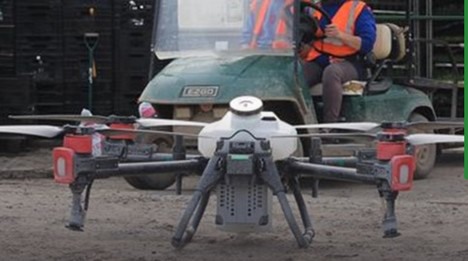As technology continues to reshape industries across the globe, the horticulture sector stands on the brink of an exciting transformation: the use of drones. These remarkable machines possess the power to revolutionize the way tasks are performed in horticulture, offering increased efficiency, improved precision, and the ability to accomplish tasks previously too difficult for conventional methods.
Drones provide a remarkable opportunity to automate and streamline various tasks, reducing reliance on skilled labor. For example, drones can effortlessly shade greenhouses or precisely apply fertilizers to crops in fields deemed too wet for tractors to navigate. With drones, operations continue seamlessly and safely.
Currently, in the UK, drones have found primary applications in three crucial areas:
- Shading paint application: Drones efficiently apply shading paint to protect crops from excessive sunlight. A job previously done by workers on the roof of the glasshouse is made significantly safer, more precise, and faster.
- Fertiliser application: Drones armed with sensors and advanced imaging technology analyze crop health and detect nutrient deficiencies. The data collected is utilized to apply fertilizers and other necessary nutrients or biostimulants with pinpoint accuracy, targeting specific areas of the crop and optimizing inputs.
- Reseeding inaccessible areas: Drones offer a ground-breaking solution for reaching areas previously deemed inaccessible or too hazardous for reseeding, such as steep roadsides. Leveraging their agility and precision, drones effectively distribute seeds in these challenging locations, contributing to vital restoration efforts.
While these uses for drones are already impressive, regulatory barriers exist when it comes to the application of plant protection products (PPPs). Strict adherence to guidelines and regulations is crucial to ensure environmental and human safety. Yet, efforts are underway to obtain authorizations for drone applications of certain products. Close collaboration between manufacturers, operators, and regulatory bodies is vital to ensure compliance and promote responsible drone usage in horticulture.

The immense potential of drones
Looking ahead, the future potential of drones in horticulture is vast:
Disease and pest monitoring and spot applications: Drones equipped with high-resolution cameras can swiftly detect early signs of disease or pest infestation in crops. This early detection enables prompt intervention, reducing crop losses and minimizing the need for extensive pesticide use. Furthermore, drones can be deployed for targeted spot applications of pesticides, ensuring precise control with minimal environmental impact.
Application of biological controls: Drones possess the capability to effectively distribute beneficial insect species over vast areas, offering a more consistent and efficient alternative to manual applications. This innovative technology could play a pivotal role in integrated pest management strategies.
Crop monitoring and yield estimation: Advanced sensors and artificial intelligence algorithms empower drones to monitor crop health, growth stages, and estimate potential yields. Armed with this valuable information, growers can make informed decisions regarding irrigation, harvest timing, and overall crop management strategies.
Improved timing of application: Some PPPs require application during periods when fields are typically wet and inaccessible, such as slug pellets or pre-emergence herbicides. By precisely timing the application of these products using drones, farmers can achieve more effective control, potentially reducing the overall number of PPPs applied to a crop over multiple years.
The integration of drone technology in horticulture holds immense potential to change common industry practices. Driven by the need for increased efficiency, productivity, and precise crop management, the potential for drones is huge. Despite regulatory challenges, collaborative efforts among stakeholders can overcome barriers related to the use of plant protection products.
Looking ahead, drones have the potential to transform horticulture even further, playing a vital role in disease monitoring, yield estimation, reduction of environmental impacts, and improving input efficiency. By embracing drone technology, the horticulture sector can unlock new levels of productivity, sustainability, and profitability, paving the way for a bright future.
For more information: Fargro
Fargro
Tel.: +44 01903 726100
[email protected]
www.fargro.co.uk
